I once lived in a model world.
How could I not?
Growing up in a small suburban community in the Pennsylvania of the 1960s and 70s, the Second World War formed a historical and cultural backdrop for the world around me. The son of a veteran of World War Two and the Korean War, every adult male I knew – or so it then seemed – participated in the struggle against either Nazi Germany and Fascist Italy, or, Imperial Japan.
For my parent’s generation, the war seemed to have been a foundational experience that generated a cultural commonality that resonated – for a little while, at least – through the immediate postwar decades. At family gatherings, or, when I quietly observed even most random, fleeting, casual interactions between adults, reminiscences of the war – sometimes humorous; occasionally grim; oftimes profound – were mentioned in a way that could briefly transcend differences in politics, or even economic and social status.
At least it then seemed as such, from my perspective.
Like many boys of my generation, I built plastic model kits of warplanes, military vehicles, naval ships, and a variety of other subjects, like Revell’s 1/48 Mercury / Gemini spacecraft. For me, building models wasn’t simply a hobby. It was my way of identifying with, if not indirectly becoming, part of the past. So, admiring my elders; with a sense of accomplishment from assembling a set of injection-molded plastic pieces into “a fighter plane!”, “an aircraft carrier!”, or “a tank!” (or a spacecraft, like Monogram Models’ beautifully produced 1/48 Lunar Module) and maybe patriotism too (though I built many kits of German and Japanese warplanes!), if I couldn’t participate in history, I would model history.
If I couldn’t command a battle tank against Panzer IVs in the hedgerows of Normandy, I could put one together. (Revell’s 1/40 M-4 Sherman) If I couldn’t launch torpedoes from a PT-boat against a Japanese destroyer as dusk quietly descended over the Solomon Islands, I could assemble one. (Revell’s 1/72 PT-109) If I couldn’t pilot a fighter plane against Me-262 jet fighters over Berlin, I could construct one. (Monogram’s 1/48 P-51B Mustang)
Then, I learned more. In fourth grade, I received a copy of William Green’s Famous Fighters of the Second World War from my uncle, who served as a Flight Surgeon in a 9th Air Force Fighter Squadron.
One day, I asked him to show me his album of wartime pictures.
He sat next to me, and, placing the album before him, began to leaf through the photographs he’d accumulated or taken during his military service. There were pictures of airfields in England and Continental Europe, with the usual array of improvised, nondescript buildings, shacks and tents associated with most any flying field. But, the majority of the images were of pilots: fighter pilots. The men were wearing flight helmets, attached to which were flying goggles (late-war style, with one-piece lenses), with the hoses of oxygen masks draped nonchalantly over their shoulders. They were seated in the cockpits of their planes – birdcage and bubbletop P-47 Thunderbolts – or, standing casually at unnamed airfields.
Whether shyly, confidently, or both, many were smiling.
My uncle flipped through the album, page by page, momentarily lingering over each image as if in silent tribute, and he continued on until the last photograph had been reached. Then, he closed the album. Upon seeing each picture, he quietly, quickly, and matter-of-factly said words to the effect of: “He’s dead.” Or, “He got killed.” Or, he would point at a picture and softly say, “Dead”. That was true for all the images, and that was all he said.
How many photographs? I don’t remember. Certainly more than ten; certainly less than thirty. Certainly enough.
Then, he returned the album to the bookshelf in his library, and walking away, said no more.
Other books were very different.
Famous Fighters of the Second World War became my favorite reading material throughout my latter years of elementary school. Even if I didn’t understand (or have much interest in) the technical development of World War Two fighter planes (I liked the “birdcage” P-51B far more than the bubble-top D version of the aircraft; still do) the many profile line drawings in Green’s book were the templates from which I created innumerable aerial battles on sheets of tracing paper. A host of other works in the same genre followed, such as Gene Gurney’s Five Down and Glory, Quentin Reynolds’ 70,000 to One, J.R.D. Braham’s Night Fighter, Walter Lord’s At Dawn We Slept, and a, plethora of paperback books published by Ballantine Books.
Then, in 1970, I discovered Scale Modeler magazine. A close-up photograph of Revell’s newly released 1/32 P-38J Lightning graced the cover. Another discovery: Al Kropff and Sydney P. Chivers’ The Art of Plastic Modelling. And then, Joseph V. Mizrahi’s duo of Wings and Airpower aviation magazines.
I was, frankly, amazed that other people – adults?- what? – who? – how?! – shared the same interests as I.
Came the autumn of 1970. History was re-created; history had become real, for the 20th Century Fox Corporation had released the movie Tora! Tora! Tora!, a cinematic depiction of Japan’s strike against America’s Pacific Fleet from both the American and Japanese viewpoints, portraying – as best as late-1960s technology and special effects would allow – the weaponry and events of the actual attack. I had to see this movie. I wanted to see P-40 Warhawks and A6M2 “Zeroes” and Nakajima B5N2 “Kates” and Aichi D3A “Vals” and the Akagi, Hiryu, and the other Japanese aircraft carriers, and of course, the battleship Pennsylvania. And at the center of everything, the USS Arizona. Or, more accurately, its demise.
(By that time, I’d known “about” Pearl Harbor. Not from family lore; not from books; not from newspapers, but from television. Namely, from “The Day The Sky Fell In”, an episode of Irwin Allen’s science-fiction series The Time Tunnel, which was broadcast by the ABC Television Network on September 30, 1966. Popular culture, it would seem, had as much potency in 1966 as in 2016…)
So, with family members, I saw the film at a theater in a small northeastern Pennsylvania town.
We arrived by car. The parking lot was jammed.
I was bored, at first. Very bored. “Why are they talking about papers and plans and diplomats and codes and cables and translations and why all the talking?! Gee, where are the ships?! When are they gonna’ show the planes?”
I was riveted, not long after. The movie brought history to life in a way that didn’t supplant Day of Infamy, but enhanced it, and prompted me to read Lord’s book anew.
In the hindsight of forty-six years, three memories remain.
The line.
The queue of theater-goers extended several hundred feet from the ticket-counter, to very the entrance of the parking lot. Perhaps it was my age, but, I’d never seen so many movie-goers waiting for a film with such anticipation and patience; with what in retrospect was a kind of deliberation. This was different. This was important. Well, it seemed so.
The silence.
We knew about the Arizona. I assumed everyone knew about the Arizona. The destruction of the battleship and the massive loss of life among her crew, singularized, epitomized, and symbolized the suddenness and devastation of the attack.
The silence in the theater is complete. Val dive-bombers fly overhead. The scene changes to the interior of one of the planes aircraft. The film’s perspective pans toward a photograph of the Arizona, coincidentally attached to the interior of dive-bomber’s cockpit (with the caption in English underneath) a visual cue to the audience about what was coming.
The ship, struck by a bomb, explodes. A quiet, collective “oomph” emerges from the crowd; their spirit deflates.
The cheers.
From Walter Lord’s book, I knew of the bravery and dedication of Second Lieutenants Kenneth M. Taylor and George Welch, and several other Army Air Corps pilots, in attempting to defend the naval base and its complex of army airfields from the Japanese attackers. I knew they had shot down several enemy planes. I knew that some of these army pilots were killed, on the ground and in the air.
And with every Japanese aircraft shot down – by Taylor and Welch; by US Navy gunners; by an Air Corps mechanic manning a heavy machine gun (casualties and devastation all around him) – a cheer; clapping; a collective “yeeaaaah!” arose from the audience. Loudly. Clearly. Distinctly. Lengthily. As if the audience was primed, wanting this to happen, waiting for this to happen.
Considering the scope of the attack, though the number of aerial victories they achieved was few, the nominal fact that the American pilots were able to “fight back” created a small beacon of pride amidst a day of unrelieved disaster – in 1969. Though the scale of their efforts was minor in comparison to the magnitude of the events of December 7, the fact that they were able to resist, was enough.
The response of the audience to the film, rather than the film itself, is my strongest memory of seeing Tora! Tora! Tora!
The film inevitably and understandably simplified complexity, location, and the specific events involved in the aerial defense of Pearl Harbor by depicting Taylor and Welch’s attacks against their opponents in a nicely filmed three-minute aerial combat sequence, using a combination of aerial footage of actual P-40s, and, AT-6s and BT-13s modified to represent Zero fighters and Kate torpedo-bombers. This is interspersed with studio footage of the actors playing Taylor (Carl Reindel) and Welch (Rick Cooper) seated in mock-ups of P-40 cockpits, behind whom a sky background is projected. (A precursor to the use of a “green-screen”, which featured in the filming of Jude Law and Gwyenth Paltrow in a P-40 cockpit, in Sky Captain and The World of Tomorrow!)
Only years later did I learn that the film received indifferent reviews and under-performed financially, partially attributable to the expenditures for ensuring realism and technical accuracy through the use of actual aircraft.
The aerial combat sequence from Tora! Tora! Tora!, posted by “Combo Breaker 96” in July of 2015, can be found at:
Tora! Tora! Tora! P-40s versus Zeroes Scene
Well, that is how I remember the world of 1970.
* * * * * * * * * *
Some decades later, while researching images pertaining to the World War Two Army Air Force at the United States National Archives, in College Park, Maryland, I discovered the Archives’ collection of “Photographic Prints of Air Cadets and Officers, Air Crew, and Notables in the History of Aviation”. This remarkable trove of photographic portraits and other images comprises 105 boxes (heavy, archival storage boxes, that is) containing several thousand – the exact number unknown – images of aviators, the overwhelming majority taken during the very late 1930s, and early 1940s; with a very small number from WW I and the twenties. A few civilian flyers (like Amelia Earhart and Anthony Fokker) are also present, along with a few images of famous German WW I aviators.
Most of the portraits are of Flying Cadets, or, men who had just graduated as Second Lieutenants and received their “wings” from Army Air Force pilot, bombardier, and navigator schools. The majority of images seem to have been taken from 1941 through 1943, with some taken in 1944, and very few thereafter.
Some pictures were taken outdoors, along an airfield flight-line, apparent from background scenery. Some, with photographic back-drops of aircraft, clouds, or other aviation-related images, were obviously taken in studios. Other were taken in very simple, unadorned, indoor settings. Some images are printed upon 8 ½” x 11” black & white glossy finish photographic paper, while others, of smaller dimensions, are mounted upon (glued to) heavy 8 ½” x 11” stock. Typically, information such the date of the photograph, name and rank of subject, and the aviation school where the image was taken is recorded with the images; sometimes on the image itself.
Inevitably, given the coincidence between the timing of their graduation and the time-frame of the Second World War, many of these men were killed in action, while others lost their lives in training or operational accidents. Similarly, it is notable that there are no photographs of aircrews; only individuals. Notably, this collection of photographs comprises a limited number of the tens of thousands Army Air Force pilots, bombardiers, navigators who were Aviation Cadets, or were commissioned, during World War Two.
* * * * * * * * * *
It was the discovery of these pictures that has led to this post.
Within the photo collection, there are images of Aviation Cadets Samuel W. Bishop (later 1st Lt., 44th Pursuit Squadron, 18th Pursuit Group), Hans C. Christiansen (later 2nd Lt., 44th Pursuit Squadron, 18th Pursuit Group), John L. Dains (later 2nd Lt., 47th Pursuit Squadron, 15th Pursuit Group), Gordon H. Sterling, Jr. (later 2nd Lt., 46th Pursuit Squadron, 15th Pursuit Group), and, George A. Whitman (later 2nd Lt., 44th Pursuit Squadron, 18th Pursuit Group). All four except Sterling were photographed at (then) Kelly Field, in San Antonio; Bishop and Christiansen in 1940, and Dains a year later.
On December of 1941, these five men were stationed at Pearl Harbor.
The only one still alive on December 8 was Samuel Bishop.
Bishop, Christiansen, and Whiteman, were stationed at Bellows Field. The events there are described in 7 December 1941 – The Air Force Story, as follows:
Personnel of the 44th Pursuit Squadron rushed out to disperse, fuel, and arm their twelve P-40 Warhawks, which were lined up on the edge of the runway. Only four of the squadron’s officers were at Bellows that morning, and three were pilots. They wanted to get into the air immediately, despite the fact that their aircraft were not completely armed, but Lieutenant Phillips, the armament officer, insisted that all six .50. caliber guns be fully loaded before any aircraft took off. As 2d Lt. Hans C. Christiansen started to get into the cockpit of his plane, he was struck in the back by enemy fire and fell at the feet of his mechanic, Cpl. Elmer L. Rund, who was standing by the lower right wing. Blood gushed out from a large hole in the life jacket of the fatally wounded pilot. Rund and his crew chief, Joe Ray, then had to quickly duck under the aircraft for protection from the strafing attack by the Japanese planes, which seemed to come at them from all directions. (27)
The third pilot at Bellows was 1st Lt. Samuel W. Bishop, who taxied into position, turned his plane toward the ocean, and began his takeoff roll directly behind Whiteman. He saw Whiteman’s plane go down after a burst of gunfire went right into the cockpit. The only emotion he felt was deep rage as he got airborne, holding the trigger down all the while, as Japanese planes swarmed around him. He retracted his landing gear and hugged the water, trying to gain speed, but the Zeros clung tenaciously to him and shot him down in the ocean about half a mile offshore. Despite a bullet wound in his leg, Bishop managed to get out of his plane and, with his Mae West keeping him afloat, swam to shore. (29)
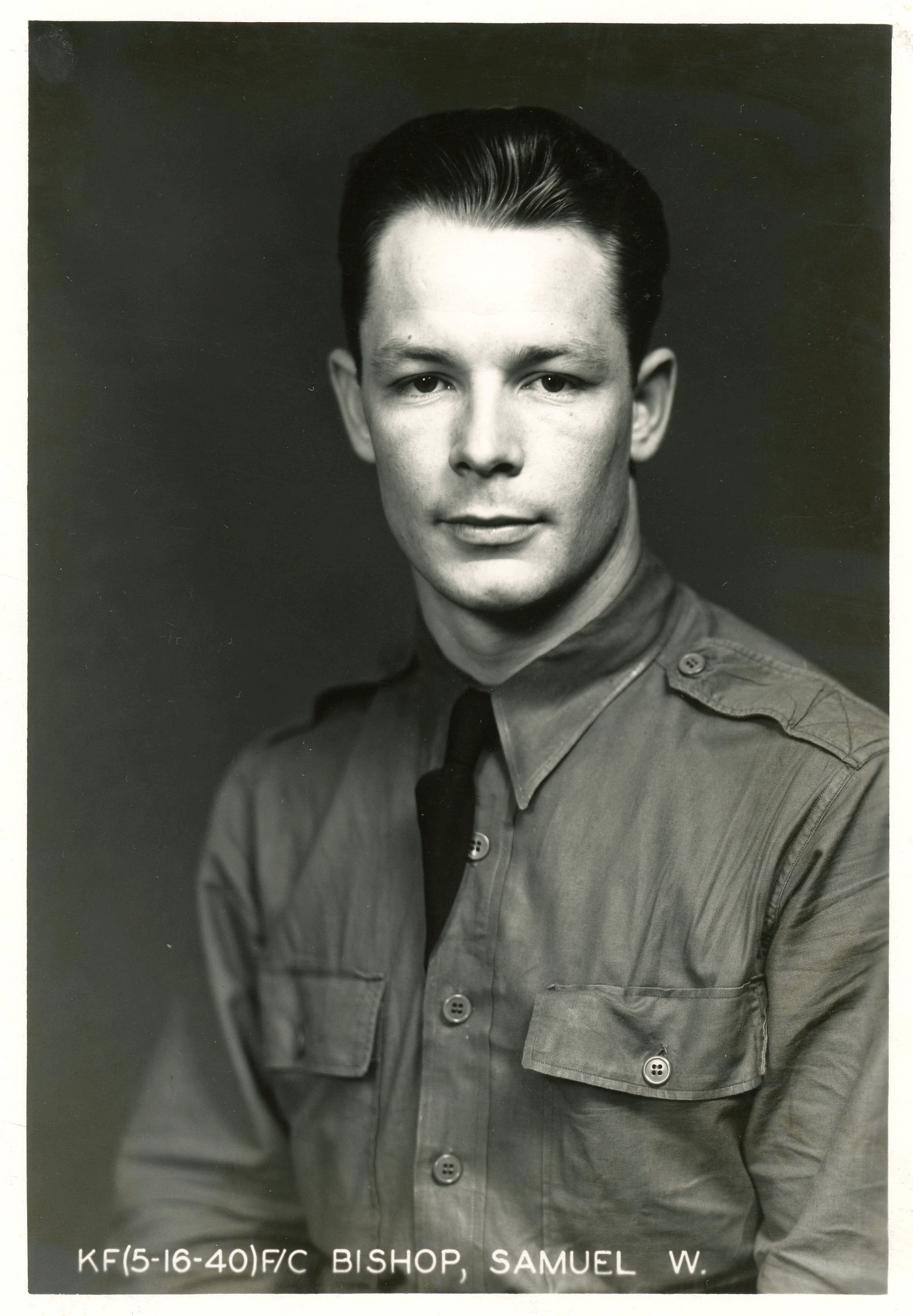 Flying Cadet Samuel W. Bishop. Photographed on May 16, 1940.
Flying Cadet Samuel W. Bishop. Photographed on May 16, 1940.
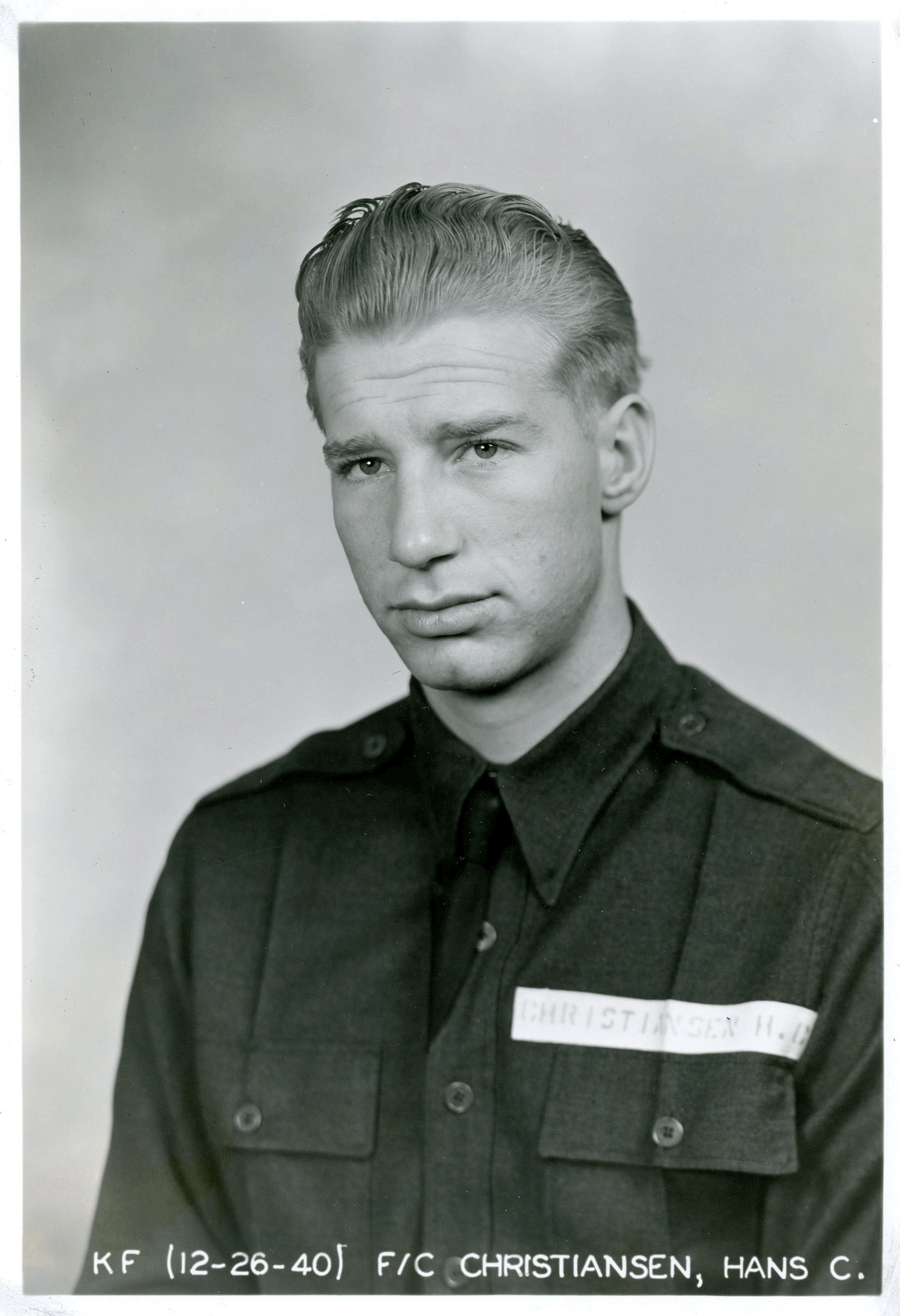 Flying Cadet Hans C. Christiansen. Photographed on December 26, 1940.
Flying Cadet Hans C. Christiansen. Photographed on December 26, 1940.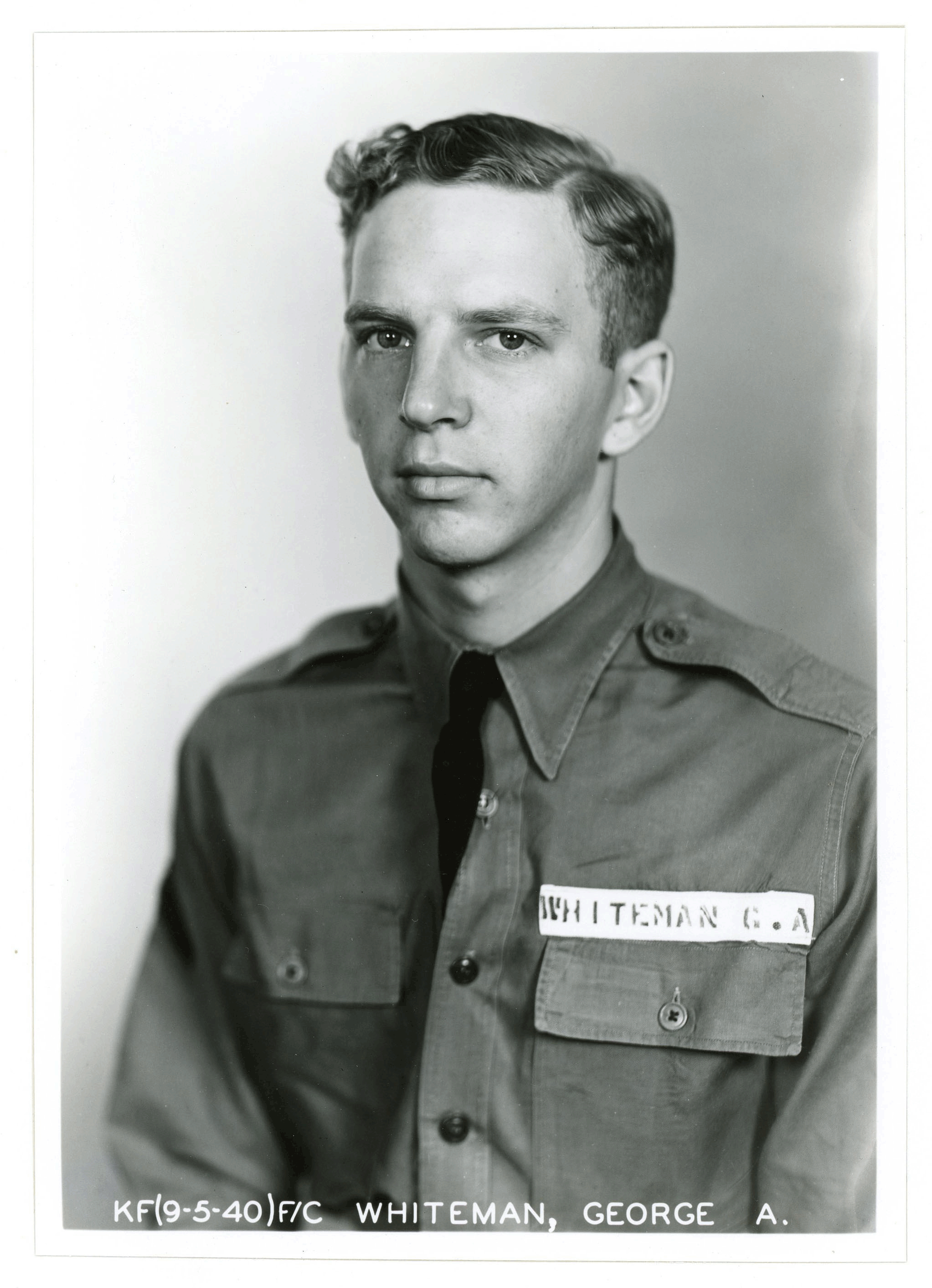 Flying Cadet George A. Whiteman. Picture taken on September 5, 1940.
Flying Cadet George A. Whiteman. Picture taken on September 5, 1940.
Biographical information for Christiansen can be found at his FindAGrave on-line memorial, as can that for Whiteman, after whose name the formerly inactivated Sedalia Army Airfield – reactivated in October of 1952 as Sedalia Air Force Base – was renamed in 1955.
Sterling was killed in what would be his first and only dogfight. As recounted in John W. Lambert’s The Long Campaign – The History of the 15th Fighter Group in World War II,
“The pilots mounted their planes, fired up their engines, and prepared for the first sortie from Wheeler. At the last minute, leaving his engine running, Norris climbed out of his cockpit and ran to get a better fitting parachute. Seeing the rest of the formation beginning to taxi out, 2nd I.t. Gordon H. Sterling, who had been standing by hoping to get into the fight, bounded into the empty cockpit of the fourth P-36. He handed his wrist watch to an astonished mechanic, and said. “See that my mother gets this. I won’t be coming back,” slammed the canopy and gunned the plane down the field.
“It was about 0850 when Sanders’ flight cleared Wheeler, entered a cloud base at 2.000 feet and headed southeast. As they broke out of the clouds at 28,500 feet Sanders advised the fighter control center of his position and availability. The fighter director reported many bogeys over Kaneohe and Bellows Fields. Sanders acknowledged, increased his climb at full throttle to 11,000 feet, and turned north.
“By this time the first wave of the Japanese attack force was streaming back to their carriers. Fuchida, cruising at 15,000 feet over Pearl Harbor, was surveying his handiwork and directing the next wave. This force, led by Lt. Commander Shigekazu Shimazaki of the Zuikaku, had been launched at 0715. It consisted of 167 Kates. Vals, and escorting Zekes. About 0850 they began to deploy for the attack run on their targets off the East Coast of Oahu.
“Shimazaki’s units struck Kaneohe and Bellows airfields and renewed the attacks on Hickam and the badly wounded fleet at Pearl Harbor. These Vals with Zekes flying top cover were the bogeys identified by fighter control who had directed the 46th Squadron’s P-36s to rendezvous. Lew Sanders relates the action:
“In a slight dive at near maximum throttle, we sighted a formation of 11 enemy planes at about 6,000 feet. I rocked my wings and the formation tightened up around me. As I began to give hand signals to my flight I saw that Sterling had some- how taken over Norris’ plane. It was quite a shock to discover this youngster in formation under such dire circumstances. However, there was no alternative but to signal him to take my right wing position. Then I directed the left element pilots to take aggressive action.
“We dived, coming in on the enemy formation at an overtaking speed, from about level flight. I fired at the leader, watched tracers enter the fuselage, saw him pull up slightly, and then fall off the right, smoking. I made a fast 360 degree turn to clear my tail and, at a very short distance ahead, saw a P-36 I thought to be my wingman. Sterling was shooting at a burning enemy plane in a near vertical dive. An instant later another enemy fighter split S-ed on Sterling’s tail. I pushed over on the three planes below me and began firing at the one on Sterling. Soon the P-36 ahead of me was on fire and spiraling slowly out of control. The Japanese fighter in my sights was in a dive, trailing white smoke.
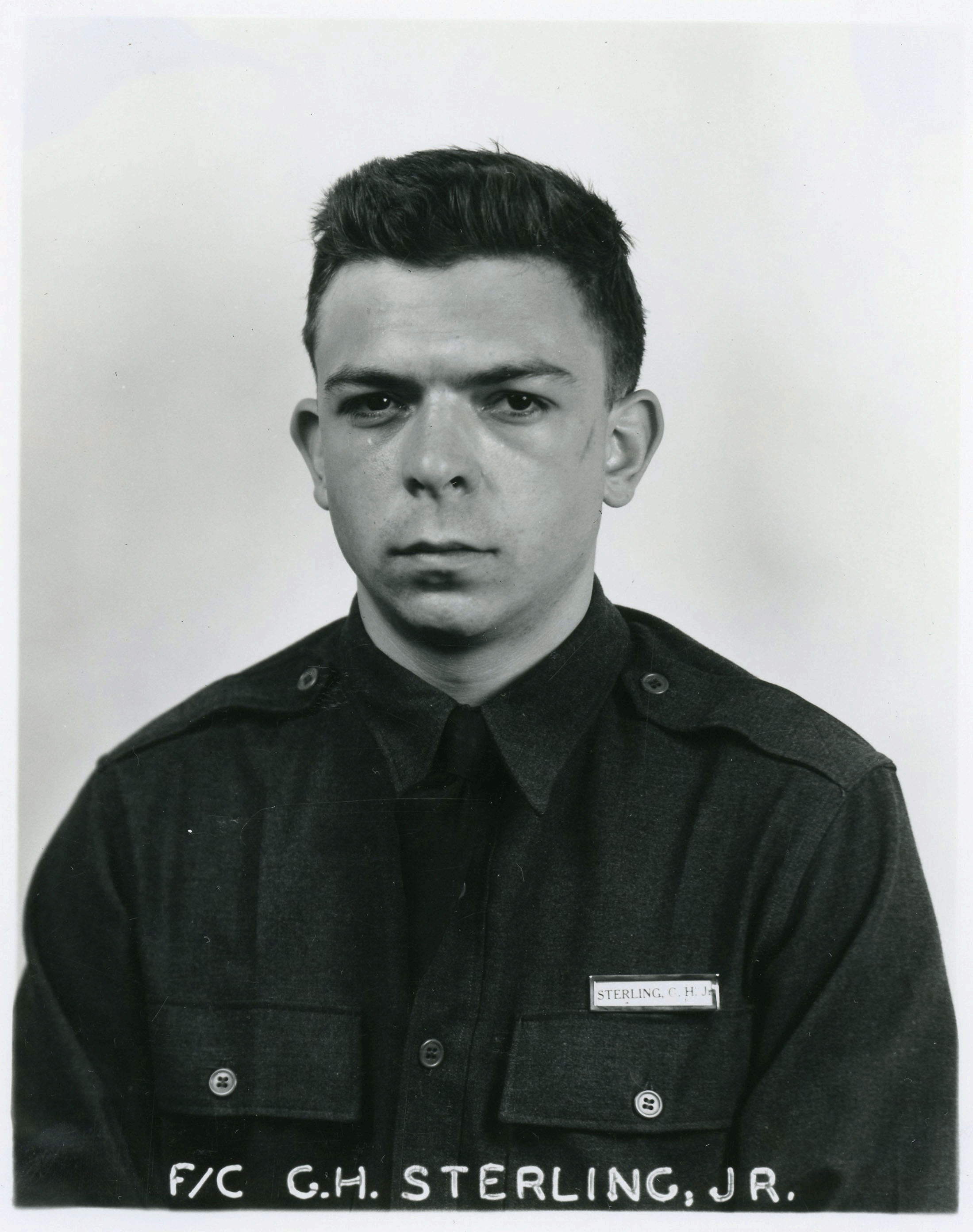 Flying Cadet Gordon H. Sterling, Jr. Date unknown.
Flying Cadet Gordon H. Sterling, Jr. Date unknown.
Lt. Sterling, whose body has never been found, is memorialized both at the Honolulu Memorial, and Arlington National Cemetery.
John Dains may have been the first American “friendly fire” fatality of the Second World War. Shot down over Schofield Barracks, his fate is described by Leatrice R. Arakaki and John R. Kuborn, John R., and also in James R. Jones’ best-selling novel, From Here to Eternity.
According to 7 December 1941 – The Air Force Story,
“While this [the attempted take-off at Bellows field by Bishop, Christiansen, and Whiteman] was going on, Haleiwa launched aircraft as fast as pilots showed up. Lts. John Dains and John Webster both got off at different times in P-40s, while Lts. Harry Brown and Robert Rogers each took off in P -36s. From Wheeler Field, Lts. Malcolm Moore and Othneil Norris entered the fight, also flying P-36s. Brown and Rogers headed out to Kahuku Point, where they engaged the enemy without any confirmed kills, but Rogers damaged one enemy aircraft. From there they joined up with Moore and Webster and headed west. At Kaena Point, Webster damaged one aircraft, but could not confirm a kill. Rogers was cornered by two Japanese; and Brown plowed into the fight, shooting down one attacker. As the action started to wind down, Moore opened up on one retreating Japanese aircraft but failed to down it. Brown spotted the smoking ship and also fired but, like Moore, could not hit a vital spot, and the aircraft got away. Rogers started to run low on fuel, so he returned to Haleiwa where he took off on his second mission in a P-36. Dains also returned to Haleiwa and got off on a second mission in a P-40.
“By this time the Japanese had completed their attack and were returning to their carriers as fast as they could. Wheeler Field and Haleiwa kept launching aircraft for the next hour with little coordination or direction for the pilots. No additional combat with the Japanese occurred. One mystery still remains concerning the action that occurred in the air that Sunday morning. Radar operators at the station at Kaaawa watched a P-40 shoot down a Japanese Zero during the height of the battle. The operators were positive the American aircraft was a P- 40, and they identified it both from its distinctive silhouette and the sound of its engine. None of the pilots that survived that morning’s action remembered flying in the Kaawa area. The only pilot whose action was unaccounted for was Lt. John Dains, who flew two missions that morning in a P-40. Both times he was separated from the other American fighters and fought by himself. After landing the second time, he switched to a P-36 and joined up with George Welch for a third mission. Neither pilot spotted anything because by that time the Japanese had cleared the area, so they decided to return to Wheeler Field. On the return flight, antiaircraft guns at Schofield Barracks opened up on the two aircraft, killing Dains. There were three plausible explanations. First, the radar operators could have been mistaken in what they saw; second, some other P-40 pilot downed the Japanese plane and was unaware where the action occurred; or third, we suspect that Dains did get the enemy plane as the ground personnel observed and just never got the chance to tell his story.
The account of Dains’ death occupies a brief passage in Jones’ lengthy and superb 1951 novel, the clarity of the description therein suggesting that Jones witnessed the event firsthand, or, learned about the story from fellow soldiers. Certainly this would be consistent with Jones’ presence at Schofield Barracks that December morning. As penned by Jones,
Lt. Ross dived under the porch for the supplyroom as another single [aircraft] came blasting in from the southeast and the roaring umbrella of fire rose from the roofs to engulf it. It seemed impossible that he could fly right through it and come out untouched. But he did.
Right behind him, but flying due north along Waianae Avenue and the Hq Building, came another plane; and the umbrella swung that way without even letting go of its triggers.
The plane’s gastank exploded immediately into flames that engulfed the whole cockpit and the plane veered off down on the right wing, still going at top speed. As the belly and left under-wing came up into view, the blue circle with the white star in it showed plainly in the bright sunlight. Then it was gone, off down through some trees that sheared off the wings, and the fuselage, still going at top speed, exploded into some unlucky married officer’s house quarters with everyone watching it.
“That was one of ours!” Reedy Treadwell said in a small still voice. “That was an American plane!”
“Tough,” Warden said, without stopping firing at the new double coming in from the northeast. “The son of a bitch dint have no business there.”
After the Jap double had flashed past, unscathed, Warden turned back and made another circuit up and down the roof, his eyes screwed up into that strained look of having been slapped in the face that he sometimes got, and that made a man not want to look at him.
“Be careful, you guys,” he said. Up the roof. Down the roof. “That last one was one of ours.” Try and be careful. Try and get a good look at them before you shoot. Them stupid bastards from Wheeler liable to fly right over here. So try and be careful after this.” Up the roof. Down the roof. The same strained squint was in his voice as was in his eyes.
From Here to Eternity
James R. Jones
(1951) 1954
New American Library (Signet Books; paperback edition), pp. 720-721
The defense of Schofield Barracks occurs three-minutes into this snippet from the full film.
It’s entertaining and well-acted, and, akin to the dogfight scene from Tora! Tora! Tora!, shows the near-inevitable, natural simplification of characters and events that occurs when a story – any story; any text (this action comprising 14 pages in the paperback edition); fiction or fact – is transformed from text to the moving image.
It’s notable that stock footage of SBD Dauntless dive bombers was used to represent Japanese bombers and torpedo plane, while AT-6 trainers – “Japanese” by virtue of the hinomarus painted on their wings and fuselages! – represent strafing Zero fighters. This was in 1953, only eight years after the war’s end, when certainly much of the viewing audience – inevitably including many recent veterans – would have recognized these incongruities.
I remember how shocked I felt when I read the above passage in Jones’ novel. I suppose it’s understandable that in the context of 1953, John Dain’s loss was not incorporated into the film. Well, at least one thing was consistent: In the film as in the Jones’ novel, the soldiers of Schofield Barracks do shoot down a Zero.
Well, no matter. Vastly different in concept, creation, and scope from Tora! Tora! Tora!, this was a film that was driven, and extremely well driven, by character, plot, and setting. The aerial attack on Schofield Barracks in From Here to Eternity (spliced from video version posted by Trena Sorman), can be viewed at:
Japanese Attack on Schofield Barracks as portrayed in From Here to Eternity (1953)
Dains is buried at the National Memorial Cemetery of the Pacific, in Honolulu.
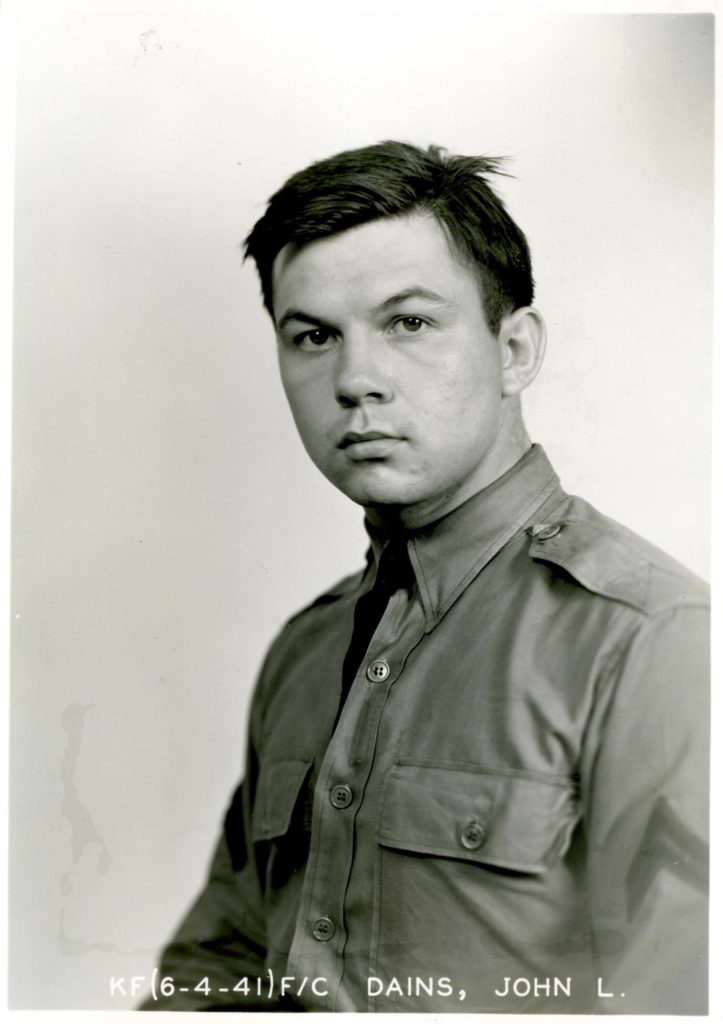 Flying Cadet John L. Dains. Picture taken on June 4, 1941.
Flying Cadet John L. Dains. Picture taken on June 4, 1941.
* * * * * * * * * *
Should you visit the National Archives to search for an image of an aviator, I’ve created a finding aid, adapted from the original document at the National Archives, which alphabetically lists the number of the box where his photograph might be found, based on and correlated to an alphabetical list of surnames. The document can be found at:
May the search for your flyer be successful.
References
Arakaki, Leatrice R. and Kuborn, John R., 7 December 1941 – The Air Force Story, 1991, Pacific Air Forces Office of History, Hickam Air Force Base, Hi.
Clausen, Christopher, Living Memory, The Wilson Quarterly, Autumn, 2004, at http://archive.wilsonquarterly.com/essays/living-memory
Howard, Clive and Whitley, Joe, One Damned Island After Another, 1946, The University of North Carolina Press, Chapel Hill, NC.
Jones, James R., From Here to Eternity, (1951), 1954, The New American Library (Signet Books), New York, N.Y.
Lambert, John W., The Long Campaign – The History of the 15th Fighter Group in World War II, 1982, Sunflower University Press, Manhattan, Ks.
Maurer, Maurer, Combat Squadron of the Air Force – World War II, 1982, Albert F. Simpson Historical Research Center and Office of Air Force History, Headquarters, USAF.
From Here to Eternity, posted by Trena Sorman on January 7, 2016, at https://www.youtube.com/watch?v=ekH3j4yh0Xg.
George Welch, at https://en.wikipedia.org/wiki/George_Welch_(pilot).
History of Whiteman Air Force Base, at http://www.strategic-air-command.com/bases/Whiteman_AFB.htm
Kenneth M. Taylor, at https://en.wikipedia.org/wiki/Kenneth_M._Taylor.
The Time Tunnel, episode directory, at http://www.tv.com/shows/the-time-tunnel/the-day-the-sky-fell-in-112761/
Tora! Tora! Tora!, Internet Movie Database entry, at http://www.imdb.com/title/tt0066473